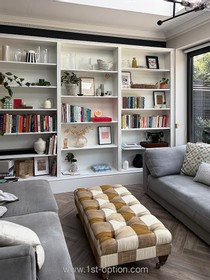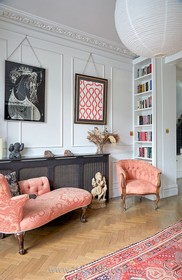It is said that book shelves originated from around the 4th century BC, initiated because of the need for storage of scrolls or papyrus rolls from the ancient Egyptians. Although easy to store due to their cylindrical shape, the scrolls were inconvenient to read, being extremely long - sometimes at more than 100 feet long. This impracticality led the Romans to eventually bring square-shaped scriptures to light, also known as a codex, which would be formed of stitched and bound folded sheets. This form was the originator of the modern book!
The invention of the printing press took place in the 15th century. Before this, manuscripts were typically transcribed and bound by monks, primarily for religious purposes. The pages would be sent for ornamentation by goldsmiths and jewellers; they were often embellished with heavy corners and other metal components, meaning that storage became necessary.
Post the printing-press invention, people began to require bookshelves in their homes. The first most common types of shelving were freestanding units with shelves that were built into the walls of the home. Bookshelves that were built-in were typically owned by the rich - most would have libraries in their homes. In the 16th century, some wealthy people started to keep smaller bookshelves in their living rooms so that they wouldn’t always need to go to their library in order to access the at-hand knowledge.
Types of modern bookshelves
In the current modern market, you can find bookshelves made of a variety of materials including metal, plastic, as well as a mix of recycled materials. However, the most common and the original material to form bookshelves is wood.
Cubic bookshelves
These shelves are formed of multiple cubic spaces, providing a symmetrical structure. Whilst allowing room for creativity when storing your books or other ornaments. Although most shelves could be found with or without backing, this type allows for more practical freedom and accessibility for storage if it is without.
Singular bookshelves
You can find bookshelves that are formed of multiple separate shelves, staggered or lined neatly on walls. Staggering these shelves allows for an interesting aesthetic in the home and can be even more eye-catching when there are a number of coloured books.
Wall bookshelves
Originating, as mentioned above, from the libraries of the wealthy, built-in wall bookshelves are the most visually and practically impactful type of the sort. They can allow an incredible amount of storage and can be found in any room as well as studies and libraries.
In modern interior architecture and design, you can find bookshelves in a range of rooms, including (and most commonly) the living room, bedrooms, home studies and even occasionally in kitchens. Over the recent years, the bookshelf, although always appreciated for its beauty, has become more often used for the effect of appearance in the modern home, as opposed to an organised library of used books. They can also be used for displaying photos, ornaments, plants and much more.
Whether they are being used for true purpose, for aesthetic purposes only, or for both, the bookshelf is a highly useful, homely and beautiful feature to any interior.
At 1st option we have plenty of locations with fantastic bookshelves, whether it be small and simple or grand and built-in.
For something bright and busy, take a look at Faberge and The Kitchen. For something more classical, peek Villa, Bella and even East Villa. If you’re seeking something with a bit more of a quirky feel, we would definitely suggest Farah, Marie or The Mill.












































































































































































































































































































































































